Q&A – Ask Neil: February 16, 2023
(Please read these instructions carefully.)
Before you post your question, please look at recent issues to see if someone else has already asked it. You might find your answer there.
How to submit your question…
• Click the link provided below to post your question. After you submit your question, a new window will pop up giving you the address to which you can e-mail a photo to accompany your question. Clear, medium-resolution photos. (Try to avoid low-res thumbnail photos, please, in case I have to zoom in to see things.)
• Click here to post your question.
• Please only post your question one time.
• One question per reader, please.
• Please use this only for posting questions – not for standard emails.
• Watch for your answer in the following week’s e-gardens.
• I choose those of greatest general interest. For example, plant IDs seldom make the cut.
• I must have your first name or initials.
• I must have your city or county. (Texas is a very large state.)
QUESTION 1
WILL CRAPE MYRTLE FILL BACK IN FROM ICE DAMAGE?
Question: The ice storm did extensive damage to our live oaks, but my crape myrtle got hit really badly. I hate topping crape myrtles, but what can I do? Can I prune out the broken limbs and hope the center will fill back in? Robert S., Round Rock.
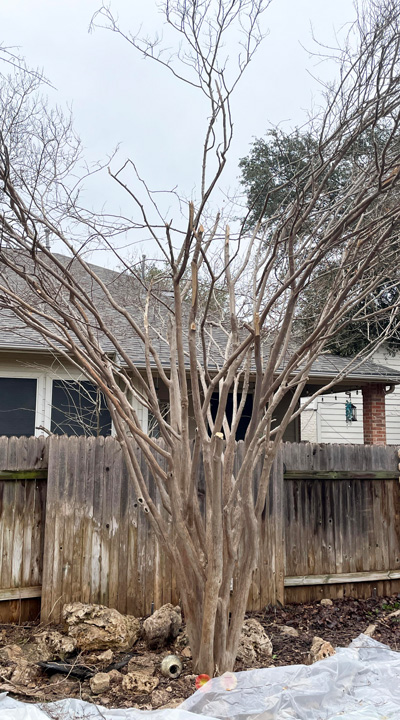
Answer: It will fill back in. You have plenty of trunks and branches. Prune and remove all that are broken completely across – those that have been left only as stubs. You do not want stubs. They will produce 10-20 new branches each, and you will never be able to conceal the scars of the damage. The next step would be to even up the numbers of stems that come up within the tree in all directions. It may even mean removing some otherwise healthy stems. Each time that you make a cut, make it flush with the trunk or with another branch. I’m just making a rough guess based on the one photo, but I would estimate that you will want to remove 40 percent of the branches and trunks I can see in the photo. That will open the tree up considerably. In the process, it will allow it to regrow and fill back in. By the end of the 2023 growing season it should look terrific.
QUESTION 2
CAN THESE TWO PLANTS BE SEPARATED AND STILL LIVE?
Question: I believe I’m growing a volunteer Japanese blueberry inside my pineapple guava’s root ball. Would it be possible to separate the two plants without killing either one? Dory D., West Harris Co.
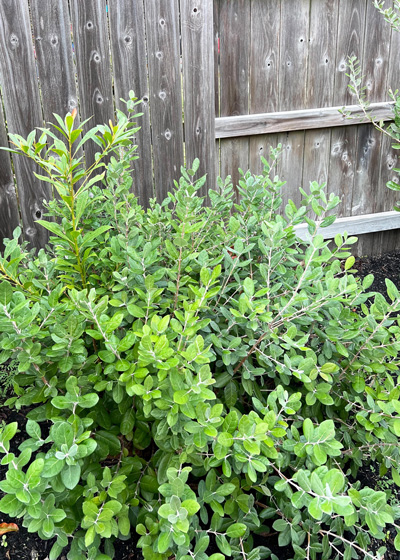
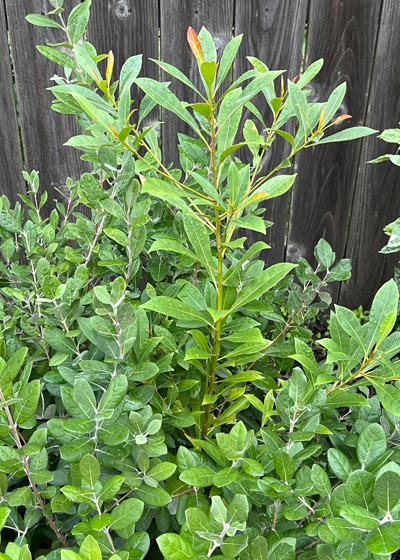
Answer: Great question, and I would say that it’s probably not going to be possible. They are both too well established. You would have to dig them up as a single root ball, and then figure a way to cut them apart with a square-bladed shovel. The risk would be quite great. It would have to be done immediately, too, before they picked up speed and started growing.
QUESTION 3
WHAT IS THE WATERING SCHEDULE FOR NEW BERMUDA SOD?
Question: Chinch bugs ate our lawn. We need a watering schedule for bermuda sod put down in early April 2023 to get the sod established before summer. I am confused by conflicting online recommendations. I want to avoid an expensive mistake and starting again. William T., Waco.
Answer: Hmm. “April 2023?” So, this sod hasn’t been planted yet? Prepare the soil carefully prior to planting. That means rototilling it with a rear-tine tiller to a depth of 3-4 inches and then raking it with a garden rake turned upside down. You want to establish a smooth planting bed that drains away from the house. Buy fresh, high-quality sod and lay it the day it arrives. Water it as soon as you can after planting it. Water every day for 5-7 minutes for the first two weeks. By then it will have its roots established and it will be ready to grow. Mow it at 1-1/2 inch from the outset and apply an all-nitrogen fertilizer (one with half of its nitrogen in slow-release form) after the second mowing. Repeat one month later at the recommended rate. Water every 4-5 days once the grass is growing actively and the temperatures climb into the 90s. Bermuda is very forgiving. You’ll be fine.
QUESTION 4
HOW SHOULD WE FILL THE HOLE WHERE A TREE’S STUMP HAS BEEN REMOVED?
Question: What is the best way to fill in the depression left by the removal of a large oak tree and the grinding of its stump? Linda A., Arlington.
Answer: Fill it with topsoil from your landscape or your neighborhood. That will avoid any kind of nutritional imbalances that vastly different types of soil might bring on. Pack the soil in tightly by walking on it every 3 or 4 inches. When you get to the top, it’s a good idea to mound it up by 1 or 2 inches. That will allow for further settling that’s sure to occur.
QUESTION 5
WHAT LOOKS LIKE HOSTAS BUT CAN TAKE THE SUN?
Question: I love hostas, but they don’t tolerate Texas sun. What would you suggest that would give me a similar look without burning up from sun most of the day? Lambs ear? I envision something like hostas in front, with something taller and green behind them for contrast. Claudia S., Corpus Christi.
Answer: It sounds like you don’t have the rear plants in place, either. I would suggest you get into a really good independent retail garden center and talk with them about your various options. I like your idea of lamb’s ear in the foreground, although I would hope the bed wouldn’t be too large. It tends to thin out if the soil drains poorly, and you must keep the flowers picked off before they develop (as you do with coleus and caladiums) or they will shut down production of new leaves. I don’t use it for large areas of groundcover. I also thought about Autumn Joy sedum. But I’m not crazy about either of those ideas without having seen the bed. That’s where your nursery professional could take you out into the garden center and show you some great combinations right in front of your eyes.
QUESTION 6
HAS OUR SHRUB DIED?
Question: Our mature bush out front looks like it’s dead. It’s right where I enjoy sitting. Should I prune it back? How low? Should I fertilize it? Most of the others died in 2020, but this one hung on. What should I do? Cindy W., Dallas.

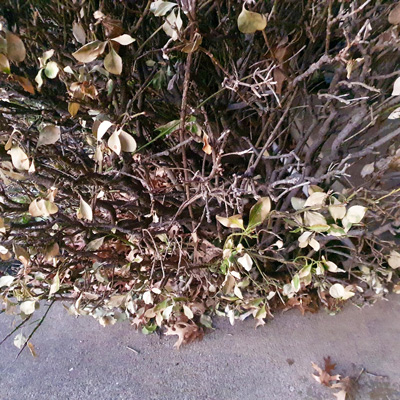
Answer: To be candid, I can’t tell if I’m looking at a waxleaf ligustrum with freeze dieback or some type of euonymus shrub that might have died from scale insects. Ligustrums in North Texas were hurt badly by the Christmas cold this year. You may have seen stories I’ve written about them here. Euonymus scale gets lots of plants each year, although I don’t see the crusty white pests on the stems of your shrub. I’m guessing that it’s freeze damage, in which case the shrubs are probably lost.
QUESTION 7
HOW AND WHEN DO I PRUNE CLEMATIS?
Question: I have made mistakes in pruning clematis in the past, ending up with dead looking vines or vines with no new growth. How and when should I prune them? Erin V., Celina, Collin Co.
Answer: Prune immediately after the spring bloom. However, most of the northern hybrid clematis types don’t grow very strongly in Texas, so be reserved in your pruning. If you’re from the North originally you will probably find that you have to prune them much less in Texas. One notable exception: sweet autumn clematis, Clematis paniculata. It is a rampant grower that should be pruned to within 2-4 ft. of the ground after the first freeze each fall. If you don’t do that pruning it will become lanky and leggy the following year.
QUESTION 8
WHAT WILL KILL DALLISGRASS WITHOUT KILLING MY NEW CEDAR ELM?
Question: I have a 4-inch cedar elm that was planted three months ago. There is well established dallisgrass near it. I’d like to spray for the dallisgrass, but I don’t want to damage my new tree. What can I use? Carolyn K., Collin Co.
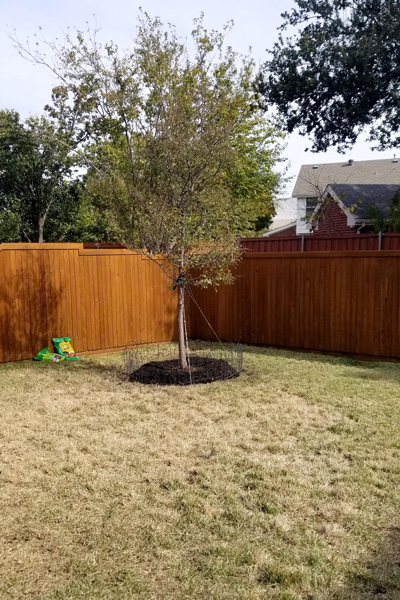
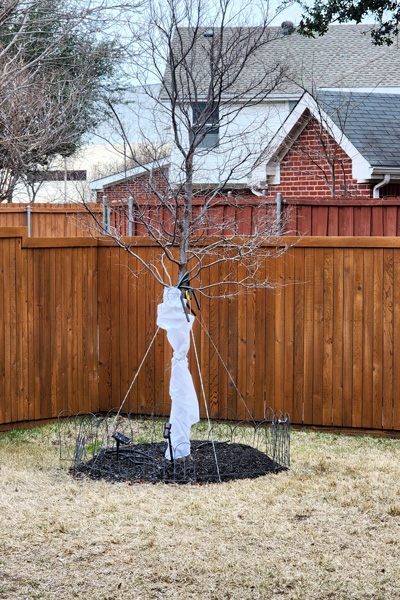
Answer: Spot-treat the dallisgrass with a glyphosate-only herbicide (no other active ingredient). If you keep it off the trunk of the tree as you spray it will not go into the soil and on to your tree. Note that glyphosate does kill other types of turfgrass, so use a spray bottle or tank sprayer, not a hose-end type for better precision.
QUESTION 9
WHAT IS THE BEST WAY TO PREVENT CHINCH BUG DAMAGE NEXT TIME AROUND?
Question: I had two acres of carpet-like St. Augustine until June 2022. Within two weeks Chinch bugs had caused early devastation. I’m probably going to have to resod 1/2-acre. How can I prevent this from happening again? Bob B., Tarrant Co.
Answer: Chinch bugs always show up first in the hottest, sunniest parts of our lawns, so you can expect them to come back to those spaces again next June. Learn to recognize the first signs of their presence. The lawn will look dry, but irrigation won’t help. It will still look dry the next morning. You can confirm chinch bugs by getting down on all fours and parting the grass to look for tiny black insects with irregular white diamonds on their wings. They will be concentrated at the outer edges of the infested area. Treat at first evidence with one of the Imidacloprid products that is labeled for chinch bugs. That will usually be in late June or early July.
